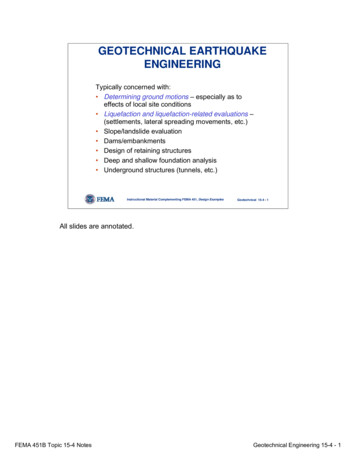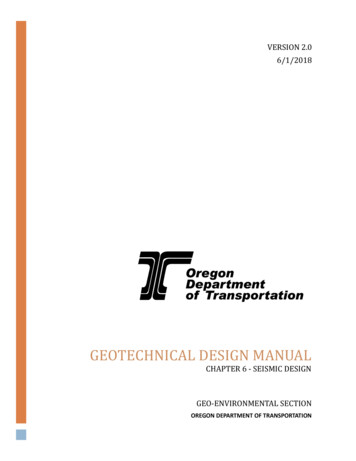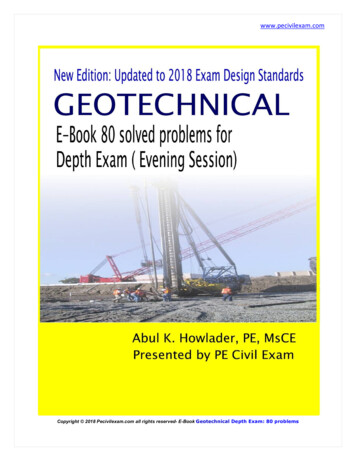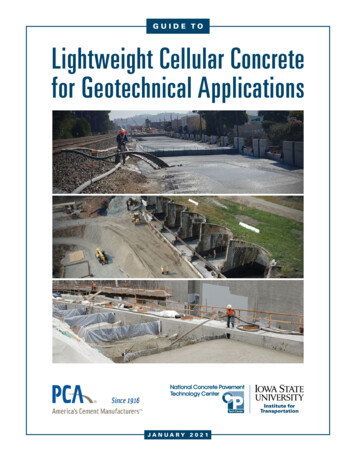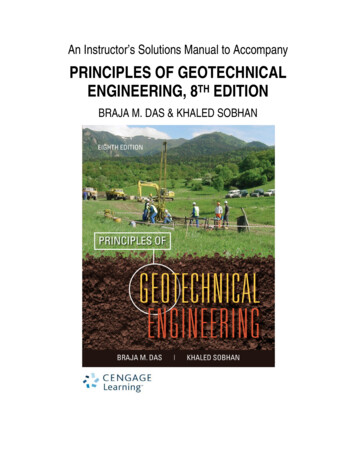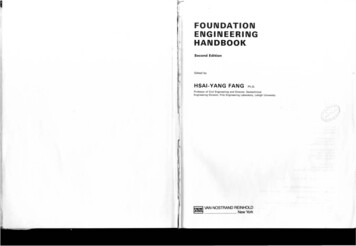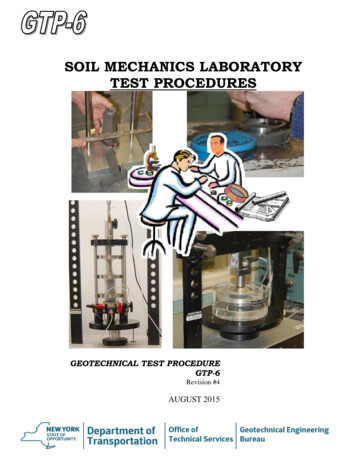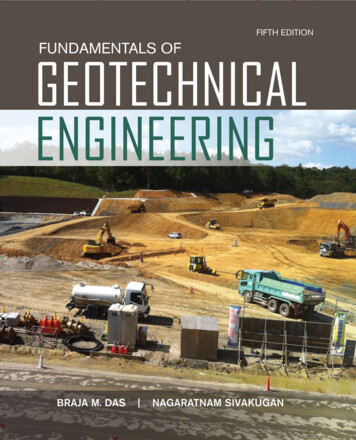
Transcription
Fundamentals ofGeotechnical EngineeringFifth EditionCopyright 201 Cengage Learning. All Rights Reserved. May not be copied, scanned, or duplicated, in whole or in part. Due to electronic rights, some third party content may be suppressed from the eBook and/or eChapter(s).Editorial review has deemed that any suppressed content does not materially affect the overall learning experience. Cengage Learning reserves the right to remove additional content at any time if subsequent rights restrictions require it.
Copyright 201 Cengage Learning. All Rights Reserved. May not be copied, scanned, or duplicated, in whole or in part. Due to electronic rights, some third party content may be suppressed from the eBook and/or eChapter(s).Editorial review has deemed that any suppressed content does not materially affect the overall learning experience. Cengage Learning reserves the right to remove additional content at any time if subsequent rights restrictions require it.
iiiFundamentals ofGeotechnical EngineeringFifth EditionBraja M. DasDean Emeritus, California State UniversitySacramento, California, USANagaratnam SivakuganAssociate Professor, College of Science, Technology & EngineeringJames Cook University, Queensland, AustraliaAustralia Brazil Mexico Singapore United Kingdom United StatesCopyright 201 Cengage Learning. All Rights Reserved. May not be copied, scanned, or duplicated, in whole or in part. Due to electronic rights, some third party content may be suppressed from the eBook and/or eChapter(s).Editorial review has deemed that any suppressed content does not materially affect the overall learning experience. Cengage Learning reserves the right to remove additional content at any time if subsequent rights restrictions require it.
This is an electronic version of the print textbook. Due to electronic rights restrictions,some third party content may be suppressed. Editorial review has deemed that any suppressedcontent does not materially affect the overall learning experience. The publisher reserves the rightto remove content from this title at any time if subsequent rights restrictions require it. Forvaluable information on pricing, previous editions, changes to current editions, and alternateformats, please visit www.cengage.com/highered to search by ISBN#, author, title, or keyword formaterials in your areas of interest.Important Notice: Media content referenced within the product description or the producttext may not be available in the eBook version.Copyright 201 Cengage Learning. All Rights Reserved. May not be copied, scanned, or duplicated, in whole or in part. Due to electronic rights, some third party content may be suppressed from the eBook and/or eChapter(s).Editorial review has deemed that any suppressed content does not materially affect the overall learning experience. Cengage Learning reserves the right to remove additional content at any time if subsequent rights restrictions require it.
Fundamentals of GeotechnicalEngineering, Fifth EditionBraja M. Das and Nagaratnam SivakuganProduct Director, Global Engineering:Timothy L. AndersonSenior Content Developer: Mona ZeftelMedia Assistant: Ashley KaupertProduct Assistant: Alexander Sham 2017, 2013 Cengage Learning WCN: 02-200-203ALL RIGHTS RESERVED. No part of this work covered by the copyrightherein may be reproduced, transmitted, stored, or used in any form or byany means graphic, electronic, or mechanical, including but not limited tophotocopying, recording, scanning, digitizing, taping, Web distribution,information networks, or information storage and retrieval systems, exceptas permitted under Section 107 or 108 of the 1976 United States CopyrightAct, without the prior written permission of the publisher.Marketing Manager: Kristin StineDirector, Content and Media Production:Sharon L. SmithSenior Content Project Manager:Kim KusnerakProduction Service: RPK EditorialServices, Inc.For product information and technology assistance, contact us atCengage Learning Customer & Sales Support, 1-800-354-9706For permission to use material from this text or product,submit all requests online at www.cengage.com/permissionsFurther permissions questions can be emailed topermissionrequest@cengage.comCopyeditor: Harlan JamesProofreader: Martha McMasterLibrary of Congress Control Number: 2015937334Indexer: Braja DasISBN-13: 978-1-305-63518-0Compositor: MPS LimitedSenior Art Director: Michelle KunklerInternal Designer: Carmela PereiraCover Designer: Tin Box StudiosCover Image: Rohini SivakuganIntellectual PropertyAnalyst: Christine MyaskovskyProject Manager: Sarah ShainwaldText and Image Permissions Researcher:Kristiina PaulSenior Manufacturing Planner: Doug WilkeCengage Learning20 Channel Center StreetBoston, MA 02210USACengage Learning is a leading provider of customized learning solutionswith employees residing in nearly 40 different countries and sales in morethan 125 countries around the world. Find your local representative atwww.cengage.comCengage Learning products are represented in Canada byNelson Education, Ltd.To learn more about Cengage Learning Solutions, visitwww.cengage.com/engineering.Purchase any of our products at your local college store or at our preferredonline store www.cengagebrain.comUnless otherwise noted, all items Cengage Learning.The cover photograph by Rohini Sivakugan is of the Shin-MeishinExpressway construction near Kyoto, Japan. This section connects Kobeand Takatsuki. The construction site is closer to Takatsuki.Printed in the United States of AmericaPrint Number: 01Print Year: 2015Copyright 201 Cengage Learning. All Rights Reserved. May not be copied, scanned, or duplicated, in whole or in part. Due to electronic rights, some third party content may be suppressed from the eBook and/or eChapter(s).Editorial review has deemed that any suppressed content does not materially affect the overall learning experience. Cengage Learning reserves the right to remove additional content at any time if subsequent rights restrictions require it.
To Janice, Rohini, Joe,Valerie and ElizabethCopyright 201 Cengage Learning. All Rights Reserved. May not be copied, scanned, or duplicated, in whole or in part. Due to electronic rights, some third party content may be suppressed from the eBook and/or eChapter(s).Editorial review has deemed that any suppressed content does not materially affect the overall learning experience. Cengage Learning reserves the right to remove additional content at any time if subsequent rights restrictions require it.
Copyright 201 Cengage Learning. All Rights Reserved. May not be copied, scanned, or duplicated, in whole or in part. Due to electronic rights, some third party content may be suppressed from the eBook and/or eChapter(s).Editorial review has deemed that any suppressed content does not materially affect the overall learning experience. Cengage Learning reserves the right to remove additional content at any time if subsequent rights restrictions require it.
Contents1GEotEChniCal EnGinEErinG—From thE BEGinninG1.11.21.31.41.51.61.71.8Introduction 1Geotechnical Engineering Prior to the 18th Century 2Preclassical Period of Soil Mechanics (1700–1776) 5Classical Soil Mechanics—Phase I (1776–1856) 6Classical Soil Mechanics—Phase II (1856–1910) 6Modern Soil Mechanics (1910–1927) 7Geotechnical Engineering after 1927 8End of an Era 14References 152Soil DEpoSitS—oriGin, Grain-SizE,anD ShapE2.12.22.32.42.52.62.7Introduction 17Rock Cycle and the Origin of SoilSoil Deposits—General 25Residual Soil 25Gravity-Transported Soil 25Alluvial Deposits 26Lacustrine Deposits 2811717viiCopyright 201 Cengage Learning. All Rights Reserved. May not be copied, scanned, or duplicated, in whole or in part. Due to electronic rights, some third party content may be suppressed from the eBook and/or eChapter(s).Editorial review has deemed that any suppressed content does not materially affect the overall learning experience. Cengage Learning reserves the right to remove additional content at any time if subsequent rights restrictions require it.
2.182.19Glacial Deposits 28Aeolian Soil Deposits 29Organic Soil 30Soil-Grain Size 30Clay Minerals 32Specific Gravity (Gs) 36Mechanical Analysis of Soil 37Sieve Analysis 37Hydrometer Analysis 40Effective Size, Uniformity Coefficient, and Coefficient of GradationGrain Shape 50Summary 51Problems 51Critical Thinking Problem 54References 553WEiGht–VolumE rElationShipSanD plaStiCity44563.13.23.3Introduction 56Weight–Volume Relationships 56Relationships among Unit Weight, Void Ratio, Moisture Content,and Specific Gravity 603.4 Relationships among Unit Weight, Porosity, and Moisture Content3.5 Various Unit Weight Relationships 643.6 Relative Density 703.7 Consistency of Soil 733.8 Activity 813.9 Liquidity Index 823.10 Plasticity Chart 833.11 Summary 84Problems 84Critical Thinking Problems 87References 874Soil ClaSSiFiCation4.14.24.34.44.5Introduction 89AASHTO Classification System 89Unified Soil Classification System (USCS)Visual Identification of Soils 100Summary 101Problems 101Critical Thinking Problems 103References 103628993Copyright 201 Cengage Learning. All Rights Reserved. May not be copied, scanned, or duplicated, in whole or in part. Due to electronic rights, some third party content may be suppressed from the eBook and/or eChapter(s).Editorial review has deemed that any suppressed content does not materially affect the overall learning experience. Cengage Learning reserves the right to remove additional content at any time if subsequent rights restrictions require it.
Contents5Soil CompaCtionIntroduction 104Compaction—General Principles 104Standard Proctor Test 105Factors Affecting Compaction 109Modified Proctor Test 111Empirical Relationships 115Field Compaction 118Specifications for Field Compaction 120Determination of Field Unit Weightafter Compaction 1225.10 Effect of Compaction on Cohesive Soil Properties5.11 Other Ground Improvement Methods 1265.12 Summary 128Problems 128Critical Thinking Problem 132References 133ix1045.15.25.35.45.55.65.75.85.91246hyDrauliC ConDuCtiVity6.16.26.36.46.5Introduction 135Bernoulli’s Equation 135Darcy’s Law 138Hydraulic Conductivity 139Laboratory Determination of HydraulicConductivity 141Empirical Relations for Hydraulic Conductivity 146Equivalent Hydraulic Conductivity in Stratified Soil 152Permeability Test in the Field by Pumping from Wells 155Summary 157Problems 157Critical Thinking Problem 161References ion 163Laplace’s Equation of Continuity 163Flow Nets 165Seepage Calculation from a Flow Net 167Flow Nets in Anisotropic Soil 171Summary 175Problems 175Critical Thinking Problem 178135163Copyright 201 Cengage Learning. All Rights Reserved. May not be copied, scanned, or duplicated, in whole or in part. Due to electronic rights, some third party content may be suppressed from the eBook and/or eChapter(s).Editorial review has deemed that any suppressed content does not materially affect the overall learning experience. Cengage Learning reserves the right to remove additional content at any time if subsequent rights restrictions require it.
xContents8StrESSES in a Soil maSS1798.1 Introduction 179Effective Stress Concept 1808.2 Stresses in Saturated Soil without Seepage 1808.3 Stresses in Saturated Soil with Seepage 1838.4 Seepage Force 1898.5 Heaving in Soil Due to Flow Around Sheet Piles 191Vertical Stress Increase Due to Various Types of Loading 1948.6 Stress Caused by a Point Load 1948.7 Vertical Stress Caused by a Line Load 1958.8 Vertical Stress Below a Uniformly Loaded Circular Area 1968.9 Vertical Stress Caused by a Rectangularly Loaded Area 1998.10 Summary 203Problems 204Critical Thinking Problems 208References 2109ConSoliDation9.19.29.39.49.59.69.7Introduction 211Fundamentals of Consolidation 212One-Dimensional Laboratory Consolidation Test 215Void Ratio–Pressure Plots 218Normally Consolidated and Overconsolidated Clays 220Effect of Disturbance on Void Ratio–Pressure RelationshipCalculation of Settlement from One-Dimensional PrimaryConsolidation 223Compression Index (Cc) and Swell Index (Cs) 225Settlement from Secondary Consolidation 233Time Rate of Consolidation 236Coefficient of Consolidation 241Calculation of Primary Consolidation Settlementunder a Foundation 248Skempton-Bjerrum Modification for ConsolidationSettlement 251Effects of Initial Excess Pore Pressure Distributionof U-Tv Relationship 255Construction Time Correction of ConsolidationSettlement 257Summary 260Problems 260Critical Thinking Problems 266References ht 201 Cengage Learning. All Rights Reserved. May not be copied, scanned, or duplicated, in whole or in part. Due to electronic rights, some third party content may be suppressed from the eBook and/or eChapter(s).Editorial review has deemed that any suppressed content does not materially affect the overall learning experience. Cengage Learning reserves the right to remove additional content at any time if subsequent rights restrictions require it.
Contents10 ShEar StrEnGth oF Soilxi26810.1 Introduction 26810.2 Mohr–Coulomb Failure Criteria 26810.3 Inclination of the Plane of Failure Caused by Shear 271Laboratory Determination of Shear Strength Parameters 27310.4 Direct Shear Test 27310.5 Triaxial Shear Test 28010.6 Consolidated-Drained Test 28210.7 Consolidated-Undrained Test 29110.8 Unconsolidated-Undrained Test 29610.9 Unconfined Compression Test on Saturated Clay 29910.10 Selection of Shear Strength Parameters 30110.11 Sensitivity and Thixotropy of Clay 30210.12 Anisotropy in Undrained Shear Strength 30410.13 Summary 305Problems 306Critical Thinking Problems 310References 31011 GrounD improVEmEnt31211.1 Introduction 312Chemical Stabilization 31311.2 Lime Stabilization 31311.3 Cement Stabilization 31511.4 Fly-Ash Stabilization 316Mechanical Stabilization 31711.5 Vibroflotation 31711.6 Dynamic Compaction 32011.7 Blasting 32211.8 Precompression 32211.9 Sand Drains 32711.10 Summary 332Problems 333Critical Thinking Problem 334References 33512 SuBSurFaCE Exploration12.112.212.312.4336Introduction 336Subsurface Exploration Program 337Exploratory Borings in the Field 340Procedures for Sampling Soil 344Copyright 201 Cengage Learning. All Rights Reserved. May not be copied, scanned, or duplicated, in whole or in part. Due to electronic rights, some third party content may be suppressed from the eBook and/or eChapter(s).Editorial review has deemed that any suppressed content does not materially affect the overall learning experience. Cengage Learning reserves the right to remove additional content at any time if subsequent rights restrictions require it.
312.1412.1512.1612.17Split-Spoon Sampling and Standard Penetration TestSampling with Thin Wall Tube 351Observation of Water Levels 352Vane Shear Test 353Cone Penetration Test 358Pressuremeter Test (PMT) 364Dilatometer Test 366Coring of Rocks 368Preparation of Boring Logs 370Geophysical Exploration 372Soil Exploration Report 379Field Instrumentation 380Summary 382Problems 383Critical Thinking Problem 387References 38834413 SlopE 13.11390Introduction 390Factor of Safety 391Stability of Infinite Slopes 392Finite Slopes 396Analysis of Finite Slope with Cylindrical FailureSurface—General 400Mass Procedure of Stability Analysis (Circularly CylindricalFailure Surface) 402Method of Slices 423Bishop’s Simplified Method of Slices 426Analysis of Simple Slopes with Steady–State Seepage 430Mass Procedure for Stability of Clay Slopewith Earthquake Forces 435Summary 439Problems 440Critical Thinking Problems 444References 44514 latEral Earth prESSurE44614.114.214.314.4Introduction 446Earth Pressure at Rest 446Rankine’s Theory of Active and Passive Earth Pressures 451Diagrams for Lateral Earth Pressure Distributionagainst Retaining Walls 45814.5 Rankine Active Pressure with Sloping Granular Backfill 471Copyright 201 Cengage Learning. All Rights Reserved. May not be copied, scanned, or duplicated, in whole or in part. Due to electronic rights, some third party content may be suppressed from the eBook and/or eChapter(s).Editorial review has deemed that any suppressed content does not materially affect the overall learning experience. Cengage Learning reserves the right to remove additional content at any time if subsequent rights restrictions require it.
Contentsxiii14.6 Coulomb’s Earth Pressure Theory—Retaining Wallswith Friction 47214.7 Passive Pressure Assuming Curved FailureSurface in Soil 48114.8 Summary 483Problems 484Critical Thinking Problems 488References 48915 rEtaininG WallS, BraCED CutS,anD ShEEt pilE WallS49015.1 Introduction 490Retaining Walls 49115.2 Retaining Walls—General 49115.3 Proportioning Retaining Walls 49315.4 Application of Lateral Earth Pressure Theoriesto Design 49415.5 Check for Overturning 49615.6 Check for Sliding along the Base 49815.7 Check for Bearing Capacity Failure 500Mechanically Stabilized Earth Retaining Walls 50815.8 Mechanically Stabilized Earth 50815.9 General Design Considerations 50915.10 Retaining Walls with Metallic Strip Reinforcement 50915.11 Step-by-Step-Design Procedure Using MetallicStrip Reinforcement 51215.12 Retaining Walls with Geotextile Reinforcement 51815.13 Retaining Walls with Geogrid Reinforcement 523Braced Cuts 52815.14 Braced Cuts—General 52815.15 Lateral Earth Pressure in Braced Cuts 53215.16 Soil Parameters for Cuts in Layered Soil 53415.17 Design of Various Components of a Braced Cut 53515.18 Heave of the Bottom of a Cut in Clay 54115.19 Lateral Yielding of Sheet Piles and Ground Settlement 543Sheet Pile Walls 54515.20 Cantilever Sheet Pile Wall in Granular Soils (c′ 0) 54515.21 Cantilever Sheet Piles in Cohesive Soils 55215.22 Anchored Sheet Pile Wall 55415.23 Deadman Anchor—A Simplified Approach 55715.24 Summary 558Problems 559Critical Thinking Problems 565References 567Copyright 201 Cengage Learning. All Rights Reserved. May not be copied, scanned, or duplicated, in whole or in part. Due to electronic rights, some third party content may be suppressed from the eBook and/or eChapter(s).Editorial review has deemed that any suppressed content does not materially affect the overall learning experience. Cengage Learning reserves the right to remove additional content at any time if subsequent rights restrictions require it.
xivContents16 ShalloW FounDationS—BEarinG CapaCity56816.1 Introduction 56816.2 Ultimate Bearing Capacity of Shallow Foundations—General Concepts 56916.3 Terzaghi’s Ultimate Bearing Capacity Theory 57116.4 Modification to Terzaghi’s Bearing Capacity Equation 57316.5 Modification of Bearing Capacity Equationsfor Water Table 57716.6 The Factor of Safety 57816.7 Eccentrically Loaded Foundations (One-Way Eccentricity) 58116.8 Reduction Factor Method for Eccentrically Loaded Strip Foundationon Granular Soil 58416.9 Strip Foundation Under Eccentrically Inclined Load 58616.10 Foundations with Two-Way Eccentricity 59116.11 Ultimate Bearing Capacity with Earthquake Condition 59916.12 Mat Foundations—Common Types 60116.13 Bearing Capacity of Mat Foundations 60416.14 Compensated Foundations 60516.15 Summary 607Problems 607Critical Thinking Problems 610References 61117 SEttlEmEnt oF ShalloWFounDationS17.1 Introduction 61217.2 Elastic Settlement of Foundations on Saturated Clay Soils(ms 0.5) 61317.3 Elastic Settlement Based on Theory of Elasticity (Drained Soil)17.4 Range of Material Parameters for ComputingElastic Settlement 62317.5 Improved Method for Settlement Calculationin Granular Soil 62317.6 Settlement of Sandy Soil: Use of Strain Influence Factor 62917.7 Allowable Bearing Pressure for Spread Footingin Sand Based on Settlement Consideration 63417.8 Allowable Bearing Pressure of Mat Foundation in Sand 63517.9 Effects of Water Table Rise on Elastic Settlementin Granular Soils 63617.10 Summary 638Problems 638Critical Thinking Problems 641References 641612615Copyright 201 Cengage Learning. All Rights Reserved. May not be copied, scanned, or duplicated, in whole or in part. Due to electronic rights, some third party content may be suppressed from the eBook and/or eChapter(s).Editorial review has deemed that any suppressed content does not materially affect the overall learning experience. Cengage Learning reserves the right to remove additional content at any time if subsequent rights restrictions require it.
Contents18 pilE Introduction 643Need for Pile Foundations 643Types of Piles and Their Structural Characteristics 645Estimation of Pile Length 653Installation of Piles 654Load Transfer Mechanism 656Equations for Estimation of Pile Capacity 659Load Carrying Capacity of Pile Point, Qp 660Frictional Resistance, Qs 662Allowable Pile Capacity 668Load-Carrying Capacity of Pile Point Resting on Rock 669Elastic Settlement of Piles 679Pile Load Tests 682Pile-Driving Formulas 687Negative Skin Friction 691Group Piles—Efficiency 693Elastic Settlement of Group Piles 698Consolidation Settlement of Group Piles 698Summary 702Problems 703Critical Thinking Problem 710References 71119 DrillED oduction 712Types of Drilled Shafts 713Construction Procedures 714Estimation of Load-Bearing Capacity 718Drilled Shafts in Sand—Net Ultimate Load 720Drilled Shafts in Clay—Net Ultimate Load 723Settlement of Drilled Shafts at Working Load 728Load-Bearing Capacity Based on Settlement 728Summary 736Problems 736Critical Thinking Problem 739References 74020 loaD anD rESiStanCE FaCtorDESiGn (lrFD)20.1 Introduction 74120.2 Design Philosophy 74220.3 Allowable Stress Design (ASD)741744Copyright 201 Cengage Learning. All Rights Reserved. May not be copied, scanned, or duplicated, in whole or in part. Due to electronic rights, some third party content may be suppressed from the eBook and/or eChapter(s).Editorial review has deemed that any suppressed content does not materially affect the overall learning experience. Cengage Learning reserves the right to remove additional content at any time if subsequent rights restrictions require it.
xviContents20.4 Limit State Design (LSD) and Partial Safety Factors20.5 Summary 750Problems 750References 750745appendix a: Geosynthetics 752answers to Selected problems 758index 767Copyright 201 Cengage Learning. All Rights Reserved. May not be copied, scanned, or duplicated, in whole or in part. Due to electronic rights, some third party content may be suppressed from the eBook and/or eChapter(s).Editorial review has deemed that any suppressed content does not materially affect the overall learning experience. Cengage Learning reserves the right to remove additional content at any time if subsequent rights restrictions require it.
prefacePrinciples of Foundation Engineering and Principles of Geotechnical Engineeringwere originally published with 1984 and 1985 copyrights, respectively. These textswere well received by instructors, students, and practitioners alike. Dependingon the needs of the users, the texts were revised and are presently in their eightheditions. These texts have also been translated in several languages.Toward the latter part of 1998, there were several requests to prepare a single volume that was concise in nature but combined the essential components ofPrinciples of Foundation Engineering and Principles of Geotechnical Engineering.In response to those requests, the first edition of Fundamentals of GeotechnicalEngineering was published in 2000. This text includes the fundamental conceptsof soil mechanics as well as foundation engineering, including bearing capacity and settlement of shallow foundations (spread footings and mats), retainingwalls, braced cuts, piles, and drilled shafts.new to this EditionThis fifth edition has been revised and prepared based on comments received fromseveral reviewers and users without changing the philosophy on which the text wasoriginally prepared. Professor Nagaratnam Sivakugan of James Cook University,Australia, has joined as a co-author of this edition. As in the previous editions,SI units are used throughout the text. This edition consists of 20 chapters and anappendix. The major changes from the fourth edition include the following: About forty additional photographs have been added.A number of additional example problems and homework problemshave been added in each chapter.Each chapter has some critical thinking problem(s) added to the homework problem set.xviiCopyright 201 Cengage Learning. All Rights Reserved. May not be copied, scanned, or duplicated, in whole or in part. Due to electronic rights, some third party content may be suppressed from the eBook and/or eChapter(s).Editorial review has deemed that any suppressed content does not materially affect the overall learning experience. Cengage Learning reserves the right to remove additional content at any time if subsequent rights restrictions require it.
xviiipreface An interactive digital version of this text is now available. Please seethe MindTap description on page xix.In Chapter 2 on “Soil Deposits—Origin, Grain-Size, and Shape” a discussion has been added for the U.S. sieve size designations. Details for theBritish standard sieves and the Australian standard sieves have also beenadded.In Chapter 3 on “Weight-Volume Relationships and Plasticity,” a tablefor various unit-weight relationships has been added.Chapter 4 on “Soil Classification” has a new section on visual identification of soils.In Chapter 5 on “Soil Compaction,” some recently published correlations for maximum dry unit weight and optimum moisture content hasbeen added. Also added in this chapter is a brief description on variousground improvement methods.Chapter 9 on “Consolidation” now has a new section on the effects ofinitial excess pore water pressure distribution on U–Tv relationships.Also added to this chapter is a discussion on the construction timecorrection of consolidation settlement.A number of recently published correlations for effective stress friction angle (f′) and cohesion (c′) for cohesive soils has been added toChapter 10 on “Shear Strength of Soils.” Also included in this chapterare several correlations for the undrained shear strength of remoldedclays with liquidity index.Chapter 12 on “Subsurface Exploration” now has a section on fieldinstrumentation.In Chapter 13 on “Slope Stability,” an analysis to evaluate the factor of safetyof clay slopes with the undrained cohesion increasing with depth has beenadded. This chapter now also has a discussion on the mass procedure for stability analysis of homogeneous clay slopes (f 0) with earthquake forces.Chapter 15 has been renamed as “Retaining Walls, Braced Cuts, andSheet Pile Walls.” Analyses of cantilever sheet pile walls and anchoredsheet pile walls have been added to this chapter.The bearing capacity of strip foundation under eccentrically inclinedload has been discussed in greater detail in Chapter 16 on “ShallowFoundations—Bearing Capacity.”An improved method for elastic settlement calculation of shallow foundations on granular soil taking into consideration the variation of soilstiffness with stress level has been added to Chapter 17 on “Settlementof Shallow Foundations.”A new chapter (Chapter 20) on “Load and Resistance Factor Design(LRFD)” has been added to the text.instructor resource materialsA detailed Instructor’s Solutions Manual and Lecture Note PowerPointslides are available for instructors through a password-protected Web site atwww.cengagebrain.com.Copyright 201 Cengage Learning. All Rights Reserved. May not be copied, scanned, or duplicated, in whole or in part. Due to electronic rights, some third party content may be suppressed from the eBook and/or eChapter(s).Editorial review has deemed that any suppressed content does not materially affect the overall learning experience. Cengage Learning reserves the right to remove additional content at any time if subsequent rights restrictions require it.
prefacexixmindtap online Course and readerThis textbook is also available online through Cengage Learning’s MindTap,a personalized learning program. Students who purchase the MindTap haveaccess to the book’s multimedia-rich electronic Reader and are able to complete homework and assessment material online, on their desktops, laptops,or iPads. Instructors who use a Learning Management System (such as Blackboard, Canvas, or Moodle) for tracking course content, assignments, andgrading, can seamlessly access the MindTap suite of content and assessmentsfor this course.With MindTap, instructors can: Personalize the Learning Path to match their course syllabus byrearranging content or appending original material to the onlinecontentConnect a Learning Management System portal to the online courseand ReaderCustomize online assessments and assignmentsTrack student engagement, progress and comprehensionPromote student success through interactivity, and exercisesAdditionally, students can listen to the text through ReadSpeaker, take notesin the digital Reader, study from or create their own Flashcards, highlightcontent for easy reference, and check their understanding of the materialthrough practice quizzes and automatically-graded homework. The MindTapfor Fundamentals of Geotechnical Engineering also includes algorithmicallygenerated problems, providing an endless pool for student practice andassessment.acknowledgmentsThanks are due to:The following reviewers for their comments and constructive suggestions: Alierza Bayat, University of AlbertaRaymond Haddad, California State University, NorthridgeAnne Lemnitzer, University of California, IrvineMatthew Sleep, Oregon
1 GEotEChniCal EnGinEErinG— From thE BEGinninG 1 1.1 Introduction 1 1.2 Geotechnical Engineering Prior to the 18th Century 2 1.3 Preclassical Period of Soil Mechanics (1700–1776) 5 1.4 Classical Soil Mechanics—Phase I (1776–1856) 6 1.5 Classical Soil Mechanics—Phase II (1856–1910) 6 1.6 Modern Soil Mechanics (1910–1927) 7
